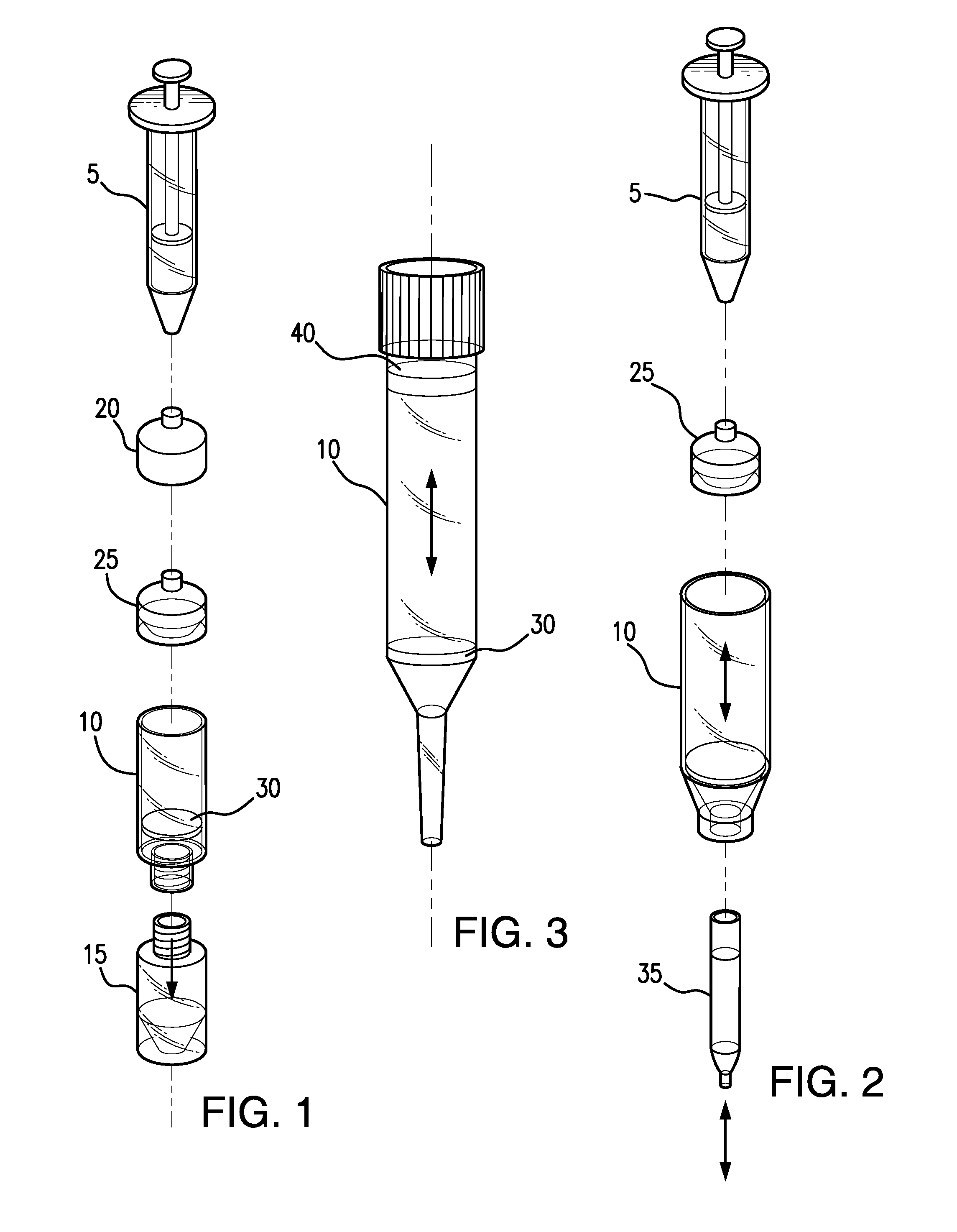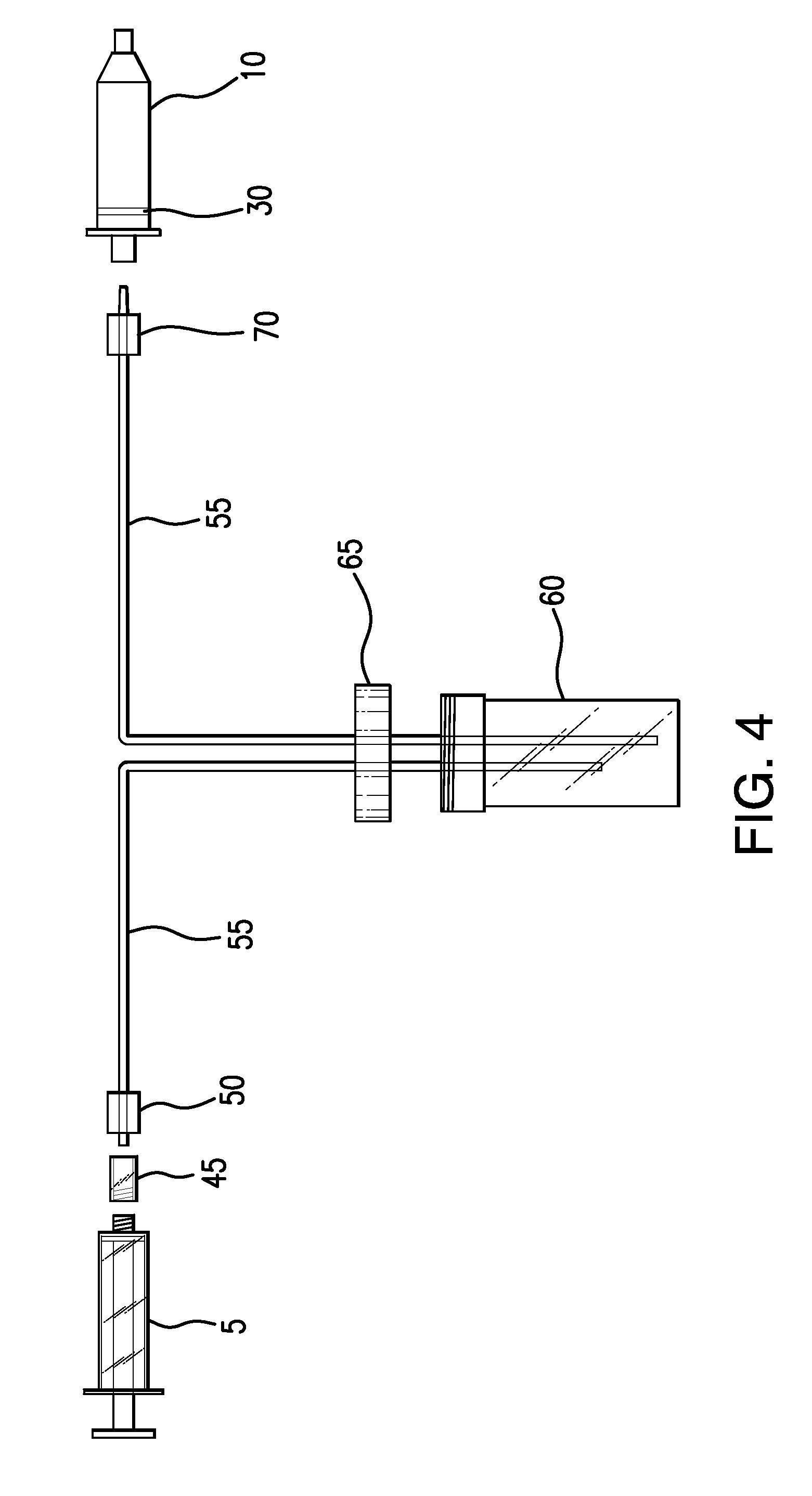Disposable, rapid extraction apparatus and methods
a technology of rapid extraction and dissolvable parts, applied in the direction of separation process, instruments, laboratory glassware, etc., can solve the problems of selling fairly complicated and often expensive nucleic acid extraction kits
- Summary
- Abstract
- Description
- Claims
- Application Information
AI Technical Summary
Benefits of technology
Problems solved by technology
Method used
Image
Examples
example 1
Analysis of RNA Extraction of H3N2 Influenza from Human Clinical Sample
[0079]A single channel micropipette with a 200 to 1000 μl range commercially available from Pipetman P1000 (Gilson, Middleton, Wis., USA) that operates by piston-driven air displacement, was used as the volume-dispensing mechanism. A sterilized, plastic O-ring was placed on either side of a borosilicate glass fiber disc (Advantec MFS, Inc., Pleasanton, Calif.). The self-sealing aerosol resistant barrier was removed from an injection molded plastic disposable pipette tip in a sterile manner. The disc and the surrounding O-rings were placed nearest the liquid contacting end in the tip so that the disc spanned the width of the pipette tip. The aerosol resistant barrier was replaced into its approximate original location and the filtration vessel was placed into a rack or stand so that the micropipettor could be attached to it without touching it.
[0080]A human clinical nasal wash sample that previously tested positiv...
example 2
Comparison of An Inventive Nucleic Acid Extraction to Prior Art
[0084]The rRT-PCR data in FIG. 6 illustrate the ability of a far simpler, more elegant, more inexpensive apparatus and method of the present invention to obtain similar extraction efficiencies, expressed as CT scores, to that of a commercially available extraction columns and methods (RNAqueous™, Ambion). In FIG.6, “delta Rn” represents the fluorescent reporter signal minus a baseline amount. The apparatus as diagrammed in FIG. 3 was used. Both apparatuses used glass-fiber filters to bind RNA in the presence of chaotropic salts. Duplicate extractions of 100 μl samples of influenza A (H1N1) 2009 virus stock (titer=105TCID50 / mL) stored in PCR grade water for each apparatus were used. Microcentrifugation was used with the commercial apparatus to drive solutions including the sample, wash, and elution buffer, through the column. The same extraction and lysis media were used for both apparatuses. Extraction efficiency was eva...
example 3
Comparison of Nucleic Acid Yield
[0085]The rRT-PCR data in FIG. 7 illustrate the ability of the apparatus and methods of the present invention to obtain increased nucleic acid yield when increasing the number of times the sample is passed over the membrane filter. In FIG. 7, “delta Rn” represents the fluorescent reporter signal minus a baseline amount. Two separate apparatuses depicted in FIG. 2 were used to extract RNA from two 100 μl samples of viral RNA from a cultured stock of influenza A (H3N2) (titer=103TCID50 / mL). A 10 mL disposable syringe (Becton, Dickinson and Company, N.J.)was used as the volume-displacing mechanism according to the invention. Both apparatuses used glass-fiber filters to bind RNA in the presence of chaotropic salts. One of the samples was drawn up into the syringe, the syringe was attached to the rest of the extraction vessel, and the plunger was pushed once so that the sample was run over the membrane filter once and the contents of the sample that did no...
PUM
| Property | Measurement | Unit |
|---|---|---|
| temperatures | aaaaa | aaaaa |
| diameter | aaaaa | aaaaa |
| diameter | aaaaa | aaaaa |
Abstract
Description
Claims
Application Information
 Login to View More
Login to View More - R&D
- Intellectual Property
- Life Sciences
- Materials
- Tech Scout
- Unparalleled Data Quality
- Higher Quality Content
- 60% Fewer Hallucinations
Browse by: Latest US Patents, China's latest patents, Technical Efficacy Thesaurus, Application Domain, Technology Topic, Popular Technical Reports.
© 2025 PatSnap. All rights reserved.Legal|Privacy policy|Modern Slavery Act Transparency Statement|Sitemap|About US| Contact US: help@patsnap.com



